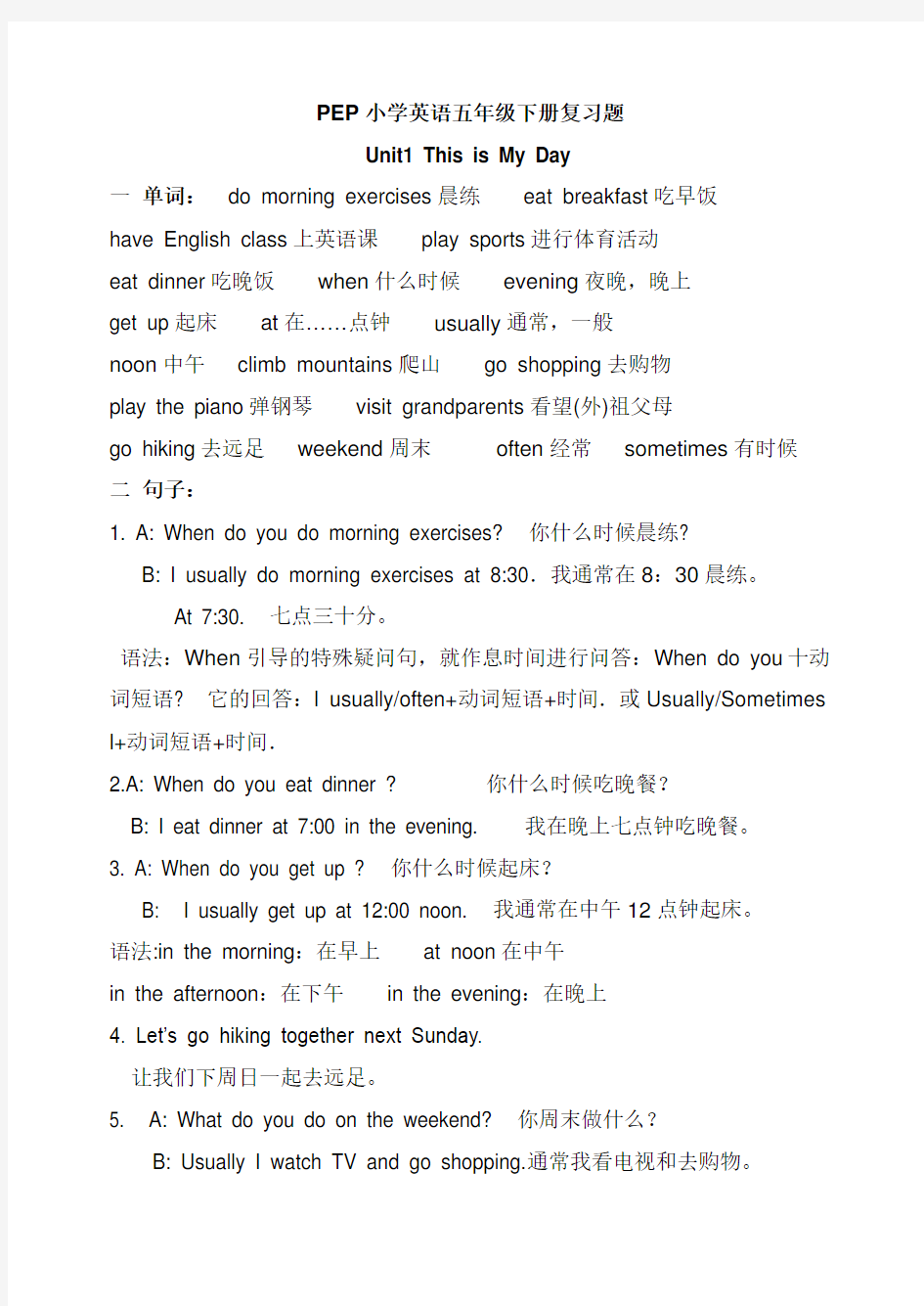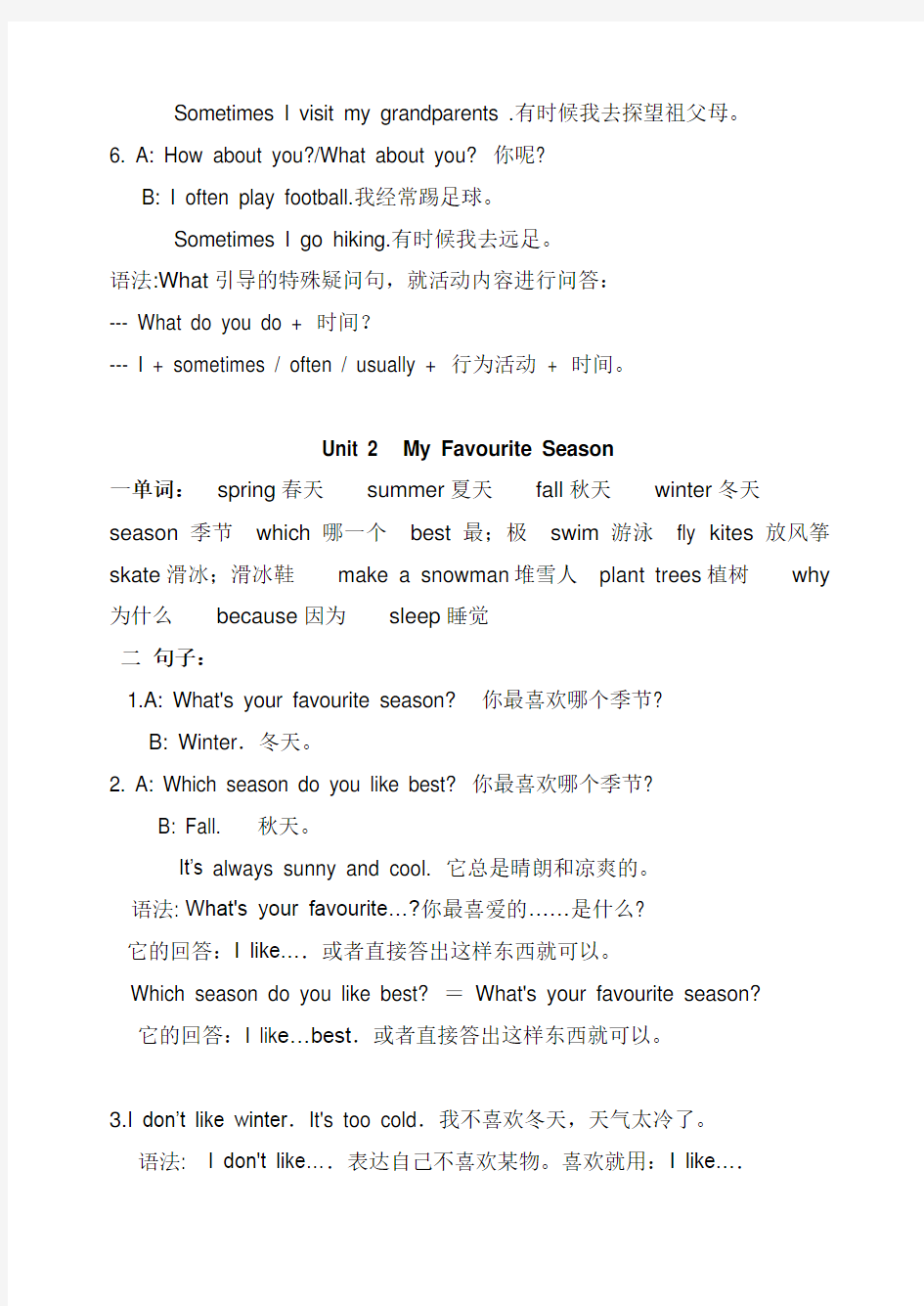

PEP小学英语五年级下册复习题
Unit1 This is My Day
一单词:do morning exercises晨练eat breakfast吃早饭
have English class上英语课play sports进行体育活动
eat dinner吃晚饭when什么时候evening夜晚,晚上
get up起床at在……点钟usually通常,一般
noon中午climb mountains爬山go shopping去购物
play the piano弹钢琴visit grandparents看望(外)祖父母
go hiking去远足weekend周末often经常sometimes有时候
二句子:
1. A: When do you do morning exercises? 你什么时候晨练?
B: I usually do morning exercises at 8:30.我通常在8:30晨练。
At 7:30. 七点三十分。
语法:When引导的特殊疑问句,就作息时间进行问答:When do you十动词短语? 它的回答:I usually/often+动词短语+时间.或Usually/Sometimes l+动词短语+时间.
2.A: When do you eat dinner ? 你什么时候吃晚餐?
B: I eat dinner at 7:00 in the evening. 我在晚上七点钟吃晚餐。
3. A: When do you get up ? 你什么时候起床?
B: I usually get up at 12:00 noon. 我通常在中午12点钟起床。
语法:in the morning:在早上at noon在中午
in the afternoon:在下午in the evening:在晚上
4. Let’s go hiking together next Sunday.
让我们下周日一起去远足。
5. A: What do you do on the weekend? 你周末做什么?
B: Usually I watch TV and go shopping.通常我看电视和去购物。
Sometimes I visit my grandparents .有时候我去探望祖父母。
6. A: How about you?/What about you? 你呢?
B: I often play football.我经常踢足球。
Sometimes I go hiking.有时候我去远足。
语法:What引导的特殊疑问句,就活动内容进行问答:
--- What do you do + 时间?
--- I + sometimes / often / usually + 行为活动+ 时间。
Unit 2 My Favourite Season
一单词:spring春天summer夏天fall秋天winter冬天season季节which哪一个best最;极swim游泳fly kites放风筝skate滑冰;滑冰鞋make a snowman堆雪人plant trees植树why 为什么because因为sleep睡觉
二句子:
1.A: What's your favourite season? 你最喜欢哪个季节?
B: Winter.冬天。
2. A: Which season do you like best? 你最喜欢哪个季节?
B: Fall. 秋天。
It’s always sunny and cool. 它总是晴朗和凉爽的。
语法: What's your favourite…?你最喜爱的……是什么?
它的回答:I like….或者直接答出这样东西就可以。
Which season do you like best? =What's your favourite season?
它的回答:I lik e…best.或者直接答出这样东西就可以。
3.I don’t like winter.It's too cold.我不喜欢冬天,天气太冷了。
语法: I don't like….表达自己不喜欢某物。喜欢就用:I like….
I like oranges.But l don't like bananas.
4. A:Which season do you like best?你最喜欢哪个季节?
B: I like winter best.我最喜欢冬天。
5. Summer is good .夏天很好。
6. But fall is my favourite season.但是秋天是我最喜欢的季节。
7. A: What would you like to do? 你想做什么?
B: I like to fly kites.我想放风筝。
8. A: Why do you like spring? 你为什么喜欢春天?
B: Because l can plant trees.因为我可以植树。
9.A: Why do you like summer? 为什么你喜欢夏天?
B: Because l can swim in the lake.因为我可以在湖里游泳。
语法: Why do you like…?为什么你喜爱…?它的回答:Because….10. A: Why do you like winter? 为什么你喜欢冬天?
B: Because l can sleep a long time.因为我可以睡很长时间。
11. A: What's the weather like in fall in Beijing?
北京秋天的天气怎么样?
B: It’s sunny and cool. 天气晴朗又凉爽
Unit 3 My Birthday
一单词:January (Jan.)一月February( Feb.)二月March(Mar.) 三月April(Apr.)四月May五月June六月July七月August (Aug.)八月September (Sept.)九月October(Oct.)十月November(Nov.) 十一月December (Dec.)十二月birthday生日uncle叔叔;舅舅first第—second第二third第三fourth第四fifth第五eighth第八ninth第九twelfth第十二twentieth第二十her她的date 日期
二句子:
1.A: When is your birthday? 你的生日是什么时候?
B: My birthday is in June.我的生日在六月。
2.A: Is your birthday in February,too?
你的生日也在二月吗?
B: No, my birthday is in December. 不,我的生日在十二月。
3. A: When is Children’s Day? 儿童节是什么时候?
B: It's in June.在六月。
常见的国内外节日还有:Tree-planting Day 植树节New Year's Da新年,元旦Army Day 建军节National Day 国庆节Christmas Day 圣诞节Mother's Day母亲节Father's Day父亲节Women's Day妇女节Teachers’Day 教师节
4.A: When is your birthday? 你什么时候过生日?
B: It’s in May. 是在5月。
5. My birthday is in June . 我的生日是在6月。
6. Uncle Bill’s birthday is in June,too. 比尔叔叔的生日也是在六月。
语法:某人’s:表示某人的,并且要注意:位于人名或姓氏之前表示亲属关系的词,其开头的字母要大写。例如:
When is Aunt Mary's birthday? 玛丽阿姨的生日是什么时候?
7. A: When is your birthday? 你什么时候过生日?
B: It’s October1,our National Day. 在十月一日,我们的国庆节。
8.A: When is your Independence Day?
你们美国的独立日是什么时候?
B: It’s July 4th. 七月四日。
语法: When引导的特殊疑问句,就什么时候过生日进行问答:
--- When is + 某人的(你的,我的,他、她的)+ birthday?
回答有多种形式:
1.My birthday is in+月份。
2.It's in +月份。
3.It's + 月日。(有具体月日,不用“in”,或者用“on”也可以。)
9.A: Who has a birthday in October? 有谁的生日在十月?
B: Me. 我。
10.A: What's the date? 几月几日?
B: It’s October 1st. 十月一日。
语法: What引导的特殊疑问句,就节日(包括生日)的具体日期进行问答:--- What's the date? --- It's + 几月几号(具体日期)。
11.A: Is her birthday in June? 她的生日在六月吗?
B: Yes. 是的。
语法: Is引导的一般疑问句,就某人的生日是否在某个时间进行提问:--- Is + 某人的+ in + 月份?--- Yes, it is. / No, it isn't.
12. A: What's the date? 几月几日?
B: June 9th. 六月九日。
13. A: Does she have a computer? 她有电脑吗?
B: Yes,she does./No,she doesn't.是的,有。/不,没有。
Unit 4 What Are You Doing?
一单词:draw pictures画画cook dinner做饭read a book看书answer the phone接电话listen to music听音乐clean the room打扫房间write a letter写信write an e-mail写电子邮件mom妈妈grandpa爷爷;外公study书房
二句子:
1. A: What are you doing? 你正在干什么?
B: I am doing the dishes. 我正在洗碗碟。
I’m reading a book.我正在看书。
语法: What引导的特殊疑问句,直接提问对方正在干什么:
--- What are you doing? --- I'm + 行为活动。
现在进行时意义:表示正在进行或发生的动作,常见的搭配有:now,Look! Listen! 它的构成是:be(am/are/is) +动词的ing形式。
动词加ing的规则
现在分词是在动词后加上ing 构成。如:starting,working, coming, sitting 等都是现在分词。现在分词的变化规则
(1)直接在谓语动词后加ing. 例如:going, starting,working,looking.
(2)去掉词尾不发音的e,再加ing. 例leaving,making,coming,writing.
注意:如果单词结尾的e发音,则不能去掉,也直接加ing. 例如:see -seeing/agree - agreeing .
(3) 对于重读闭音节词,双写末尾字母再加ing. 例如:sit--sitting, begin--beginning,get--getting,put--putting. run - running stop - stopping cut - cutting put - putting
2. This is Zhang Peng .我是张鹏。
语法: 这是打电话用语,用来介绍自己。千万不能说成:I am Zhang Peng.
3.A: What is your father doing? 你爸爸在干什么?-
B: He's writing an e-mail. 他在写电子邮件。
语法: What引导的特殊疑问句,提问对方、某人正在干什么:
--- What is + 某人+ doing? --- He / She / 某人+ is + 行为活动(doing). 4. A: Can l speak to your mom,please?
请问,我可以跟你妈妈说吗?(打电话用语)
B: She’s cooking dinner.她正在做晚饭。
Please hold on.请等一下。打电话用语。
5.There is a call for you.有一个电话找你。
语法:打电话用语:
Can l speak to him/her,please?请问,我可以跟他/她说吗?him/her:他/她(宾格)
I'm coming . Who's that?我来了。谁啊?“Who's that'”用来问对方是谁,不能说成:Who are you?
介绍自己:This is / It's + 自己的名字.
要找某人:Can I speak to + 要找的人
请稍等:Please hold on.
6.Grandpa is writing a letter.Brother is doing homework.Mom is cooking dinner in the kitchen.
爷爷正在写信。哥哥在做功课。妈妈在厨房里做饭。
7. He’s writing an e-mail in the study.
他正在书房写邮件。
Unit 5 Look at the Monkeys
一单词:fly飞jump跳walk走run跑swim游泳kangaroo袋鼠sleep睡觉climb爬fight打架swing荡;荡秋千drink water喝水
二句子:
1. Look at the tiger.看这只老虎。
2.I see them other elephant.我看见了大象妈妈。
语法: Look & see的区别:look强调“看”这个动作,后面要跟at搭配;
see则强调看到的结果。还要注意的是:
mother elephant:象妈妈,不能说成:elephant mother
baby kangaroo:袋鼠宝宝,不能说成:kangaroo baby
3.The rabbit is jumping. 兔子正在跳跃。
4. A: What is it doing? 它正在干什么?
B: It's eating bananas. 它正在吃香焦。
5. A: What is she doing? 她正在干什么?
B: She's jumping. 她正在跳。
语法:这是主语是第三人称单数的现在进行时。
What引导的特殊疑问句,谈论动物(单数)的动作:
--- What is it / he / she doing? --- It's / He's / She's + 动作(doing)。
6.That elephant is drinking water with its trunk.
那只大象用它的象鼻喝水。
语法: With:和……一起,用。在这里是“用”的意思。
7.A: What are the elephants doing? 大象们在干什么?
B: They are drinking. 它们在喝水。
语法:这是主语是复数的现在进行时。
What引导的特殊疑问句,谈论动物(复数)的动作:
--- What are they doing? --- They are + 动作(doing)。
8. A: What are they doing? 它们正在做什么?
B: They are swimming. 它们正在游泳。
They are climbing trees. 它们正在爬树。
9.Here come two big tigers.来了两只老虎。
10. A: Can tigers really swim? 老虎真的会游泳吗?
B: Yes, they can. 是的,它们会。
11.They are good climbers.它们是攀登能手。
Unit 6 A Field Trip
一单词:take pictures照相watch insects观察昆虫pick up leaves采
摘树叶do an experiment做实验catch butterflies捉蝴蝶count insects数昆虫collect leaves收集树叶write a report写报告play chess捉棋have a picnic举行野餐
二句子:
1.A: What is Mike doing'? 迈克在干什么?
B: He's watching insects.他正在观察昆虫。
2.They are in the woods.他们在树林里。
Woods:树林in the forest:在森林。
3.A: Are they catching butterflies? 他们正在捉蝴蝶吗?
B: No,they aren't.不,它们没捉。
语法: 这是They are catching butterflies的一般疑问句。
4. A: Are you eating lunch? 你(们)在吃午饭吗?
B: NO,we aren't.不,我们没吃。
语法:这是“I am eating lunc h.’’或者“We are eating lunch.’’的一般疑问句。
5.A: Are they eating the honey? 它们在吃蜂蜜吗?
B: Yes,they are.是的。
6.A: Is he taking pictures? 他在照相吗?
B: No,he isn't.不,他没照。
7. A: Is he playing chess? 他正在下棋吗?
B: Yes, he is. 是的,他是。
8.A: Is she counting insects? 她正在数昆虫吗?
B No, she isn`t.不,她没有。
I. 人称代词:人称代词又分为主格和宾格形式.主格通常做主语。宾格通常做动词或介词的宾语.
Eg: a. I’m a nurse.
b.Can you help me ?
II. 物主代词又分为形容词性的物主代词和名词性的物主代词.
形容词性的物主代词:相当于形容词,后面要跟名词,指定名词的所属对象.
名词性的物主代词:相当于一个名词,必须单独使用,后面不能再跟名词. Eg: a. Your school is small, mine is big.(=my school)
b. This is not your pen. Yours is on the desk.(=your pen)
*人称代词划线,常用who (宾格可用whom)提问.物主代词划线常用whose提问。
(特别提示):并列人称代词的排列顺序
1)单数人称代词并列作主语时,其顺序为:
第二人称-------第三人称--------第一人称
you ------- he/she/it -------- I
eg: You,he and I should return on time.
2)复数人称代词作主语时,其顺序为:
第一人称------- 第二人称-------第三人称
We------you---------They
III.指示代词: this 这个, that 那个these这些those那些